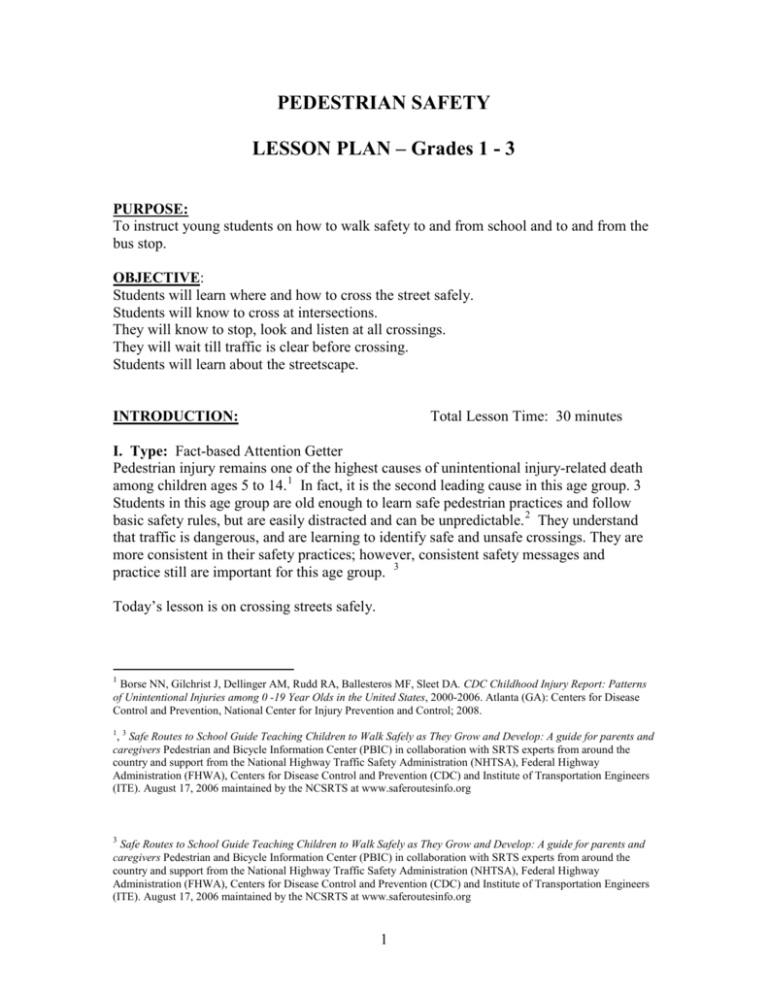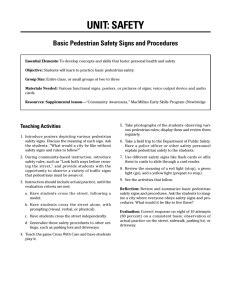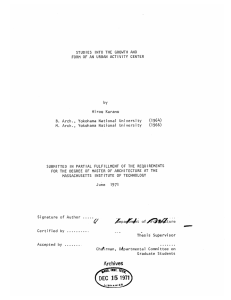PEDESTRIAN SAFETY LESSON PLAN
advertisement

PEDESTRIAN SAFETY LESSON PLAN – Grades 1 - 3 PURPOSE: To instruct young students on how to walk safety to and from school and to and from the bus stop. OBJECTIVE: Students will learn where and how to cross the street safely. Students will know to cross at intersections. They will know to stop, look and listen at all crossings. They will wait till traffic is clear before crossing. Students will learn about the streetscape. INTRODUCTION: Total Lesson Time: 30 minutes I. Type: Fact-based Attention Getter Pedestrian injury remains one of the highest causes of unintentional injury-related death among children ages 5 to 14. 1 In fact, it is the second leading cause in this age group. 3 Students in this age group are old enough to learn safe pedestrian practices and follow basic safety rules, but are easily distracted and can be unpredictable. 2 They understand that traffic is dangerous, and are learning to identify safe and unsafe crossings. They are more consistent in their safety practices; however, consistent safety messages and practice still are important for this age group. 3 Today’s lesson is on crossing streets safely. 1 Borse NN, Gilchrist J, Dellinger AM, Rudd RA, Ballesteros MF, Sleet DA. CDC Childhood Injury Report: Patterns of Unintentional Injuries among 0 -19 Year Olds in the United States, 2000-2006. Atlanta (GA): Centers for Disease Control and Prevention, National Center for Injury Prevention and Control; 2008. 1 3 , Safe Routes to School Guide Teaching Children to Walk Safely as They Grow and Develop: A guide for parents and caregivers Pedestrian and Bicycle Information Center (PBIC) in collaboration with SRTS experts from around the country and support from the National Highway Traffic Safety Administration (NHTSA), Federal Highway Administration (FHWA), Centers for Disease Control and Prevention (CDC) and Institute of Transportation Engineers (ITE). August 17, 2006 maintained by the NCSRTS at www.saferoutesinfo.org 3 Safe Routes to School Guide Teaching Children to Walk Safely as They Grow and Develop: A guide for parents and caregivers Pedestrian and Bicycle Information Center (PBIC) in collaboration with SRTS experts from around the country and support from the National Highway Traffic Safety Administration (NHTSA), Federal Highway Administration (FHWA), Centers for Disease Control and Prevention (CDC) and Institute of Transportation Engineers (ITE). August 17, 2006 maintained by the NCSRTS at www.saferoutesinfo.org 1 II. Establish Credibility: How many of you walked today?! Tell us about a time when you saw a walker have a “close call” with a motor vehicle. [Students will have some stories to tell.] Today, we’re going to talk about some ways you can keep yourself and your friends safe while walking, and we’ll talk about some additional cues and clues on the streets [“streetscape’] to increase your safety. III. Preview Main Points: Today, we will talk about and practice some easy things you can do to walk safely. PRESENTATION: Type: Lecture + Discussion + Activity Materials: Red Light/Green Light Game [Template for flash cards is at the end of this Lesson Plan.] You will need: 5 Flash Cards colored this way: 1) Red Light/ WALK; 2) Red Light/ DON’T WALK; 3) Yellow Light/ DON’T WALK; 4) Green Light/ WALK; 5) Green Light/ DON’T WALK Flipchart or chalk board or power point on which to write the Pedestrian Safety Rules Outline: Choosing a Route 1st Main Point: With a trusted adult, pick a route to and from school or the bus stop and practice it. Always walk along the route you and your parent/ guardian picked. Choose a route with the fewest street crossings. When you are going to cross streets, pick intersections with a stop light or stop sign if possible. Avoid crossing busy streets. Walk on sidewalks whenever possible. Does anybody have any questions about this basic idea? Transition: Now, let’s talk about some good walking safety rules. First of all, what is a “pedestrian?” Did you know that it comes from a Latin word meaning “feet?” So, we’re going to talk about how to use our feet [and eyes and ears] to walk safely. 2nd Main Point: Pedestrian Safety Rules: Let’s talk about each of these. [In discussion, have students point out the benefits of following these rules – eg., By avoiding crossing between parked cars, drivers can see you and avoid hitting you.] 1. Always cross at an intersection- at a corner. You can cross in the middle of a street if there is a painted crosswalk. 2. Never cross between parked cars. 3. Never run out into the street. 2 4. Only cross where you are able to see both ways down the street. Don’t assume cars can see you just because you can see them. 5. If you have the choice of crossing at a corner with a signal or stop sign, cross there! 6. Cross corner to corner. Do not cross diagonally. 7. Walk inside the crosswalk if one is there and walk in a straight line. Does anyone have any questions? Transition: There are other walking and biking cues and clues on the street to help you move safely. These signs, markings, and other parts of the landscape make up the streetscape. 3rd Main Point: The Streetscape: Have students draw on board examples of stop signs, traffic lights, pedestrian lights, painted crosswalks. Explain the differences between the traffic light and the pedestrian signal: 1. Just because a light is green does not mean it is safe to walk. 2. You must wait for the walk sign! A blinking hand means to finish crossing if you have started, but not to start if you are on the corner. 3. A solid orange hand means don’t walk. 4. Wait on the curb until cars have stopped and you have made eye contact with the driver, then cross. 5. Keep looking and listening for traffic as you cross. Transition: Okay, let’s play with what we learned. Suggested Activity: Red Light/Green Light Game Have students line up across the room. Play same as you would the game Red Light/Green Light, but instead of calling out the color of the light, show students flashcards. Reinforce the message: Stop, Look and Listen. Stop at the curb- at the edge of the corner. Look for cars- look left then right then left again! Look over your shoulder for cars that may be turning. Listen for traffic. Watch the other signs and symbols on the streetscape. Cross when it is clear. Any Questions? Transition and CONCLUSION: You have learned the basic safety rules for walking [being a “pedestrian.”] On the way home tonight, make a list of the signs and symbols you see to help people walk safely – just like you learned. Compiled by Rebecca Gomez Minneapolis Bicycle Ambassador, Department of Public Works Edited and Formatted by Lynne Krehbiel-Breneman J.D., M.A., Consultant to MPS Safe Routes to School, aided by Robert Anderson, MPS Transportation Department Academy Administrator; Summer, 2010 3





